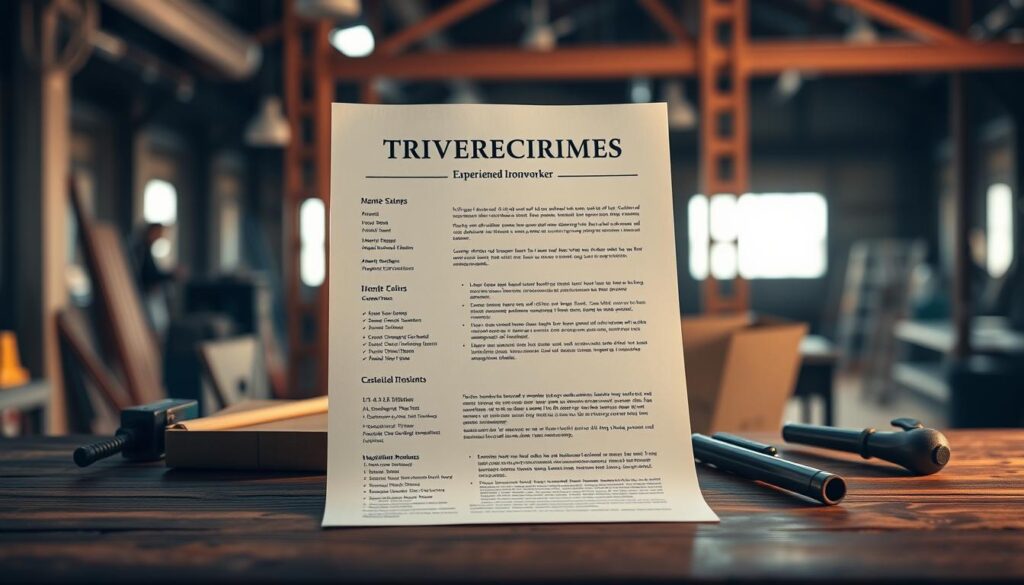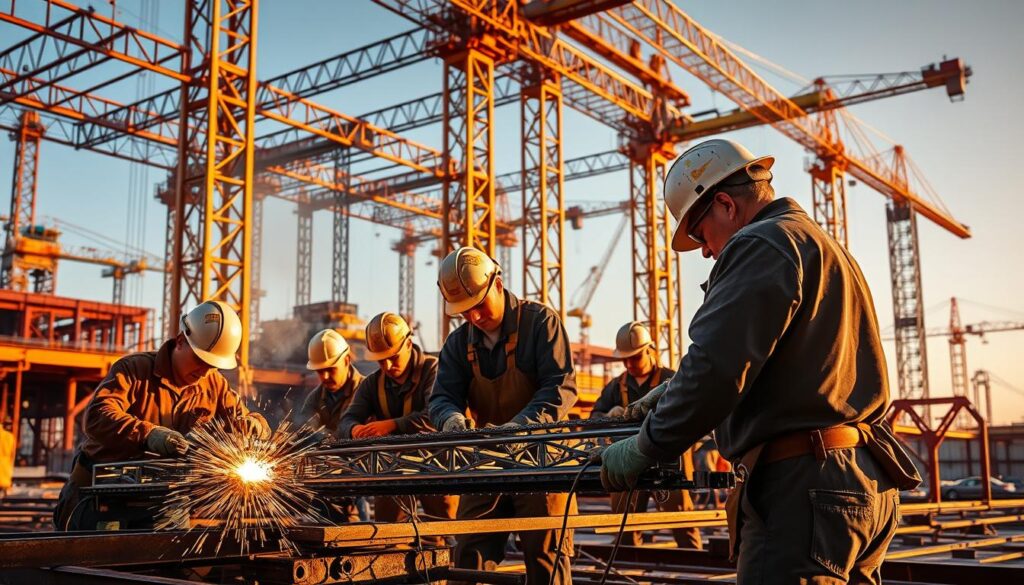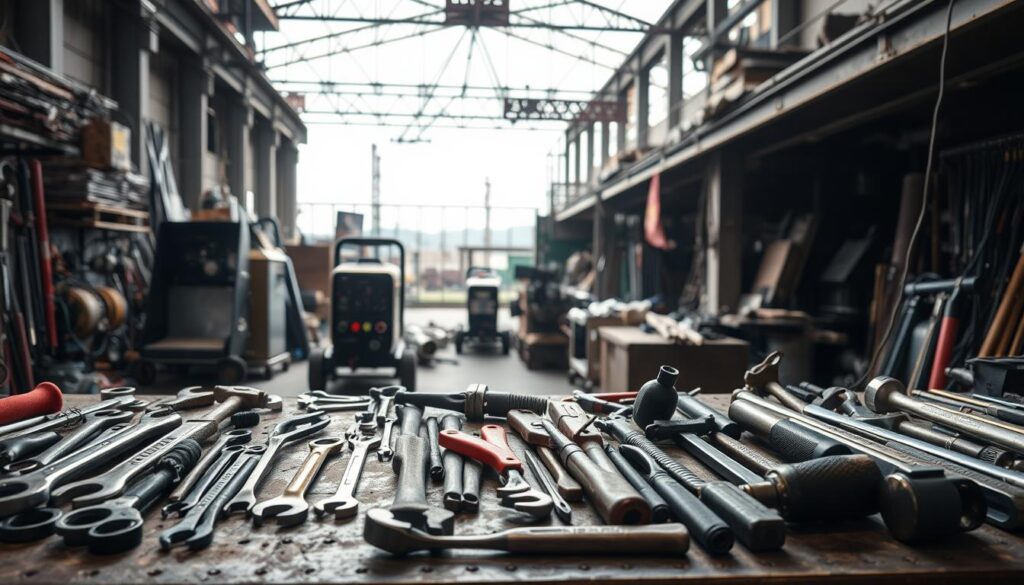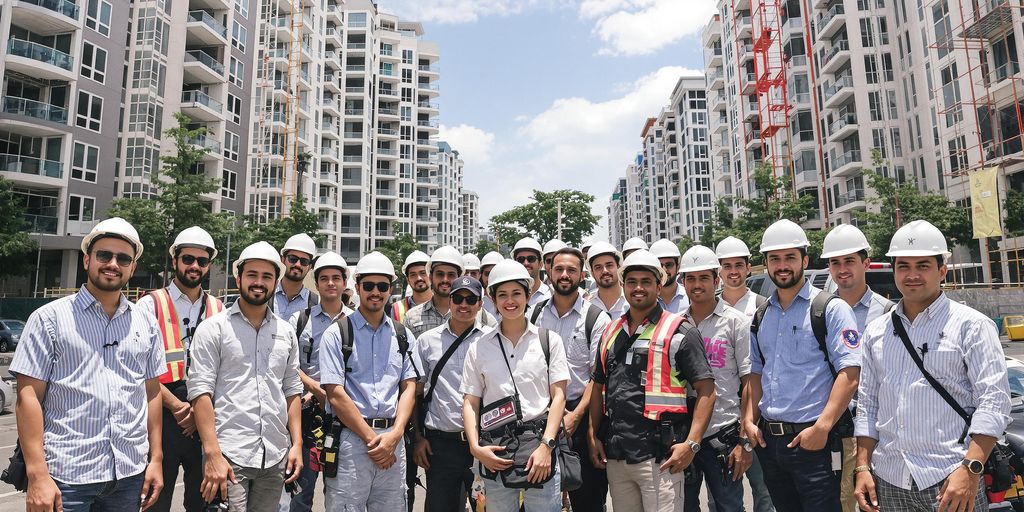Did you know the U.S. will need over 10,000 new ironworkers by 2025 to meet infrastructure demands? These skilled professionals shape America’s skyline, constructing everything from stadiums to bridges. With journeymen earning $60,000+ annually and apprenticeships offering paid training, this career combines financial stability with hands-on impact.
Breaking into this field requires more than physical stamina. Employers now prioritize candidates who pair technical skills with modern job-search strategies. Tools like RoboApply’s AI resume builder and resume examples help craft applications that beat automated screening systems. The platform’s interview coach even simulates real hiring scenarios.
You’ll need certifications in welding, rigging, or OSHA safety to stand out. Many states require completion of apprenticeship programs, which blend classroom learning with on-site experience. RoboApply’s job tracker simplifies finding these opportunities, while its ATS optimizer ensures your application gets seen.
Key Takeaways
- High demand for ironworkers will create 10,000+ openings by 2025
- Earn $30,000+ during apprenticeships, $60,000+ as a journeyman
- Use AI tools like RoboApply to create employer-ready resumes
- Physical fitness and safety certifications are non-negotiable
- Specialized welding skills increase earning potential
- Practice interviews using simulated employer scenarios
Understanding the Ironworker Trade
From bridges to stadiums, ironworkers turn architectural plans into physical reality using steel as their primary medium. These professionals handle structural components like beams, columns, and rebar systems that form the skeletons of modern construction projects. Daily tasks range from welding metal frameworks to interpreting complex blueprints – every action requires precision and adherence to strict safety standards.
Specializations define career paths within the field. Structural ironworkers focus on erecting steel frames for skyscrapers and industrial complexes, often working hundreds of feet above ground. Reinforcing teams install rebar grids that strengthen concrete foundations, while ornamental experts craft visible metal features like staircases and decorative facades.
The job demands physical endurance and technical knowledge. You’ll regularly lift 50+ pounds, operate heavy machinery like cranes and torches, and collaborate with engineers to resolve on-site challenges. Safety protocols govern every task, from harness checks for aerial work to proper welding ventilation procedures.
Major projects follow aggressive timelines, particularly in infrastructure development and renewable energy sectors. Solar farm installations and bridge repairs now account for 40% of ironworker contracts, according to recent industry reports. Those entering the field often start through structured apprenticeship programs, which combine classroom learning with hands-on experience.
How to Land a Ironworker Job in 2025
Begin by confirming you meet the non-negotiable requirements: minimum age of 18, high school diploma or GED, and ability to pass drug screenings. Physical fitness matters – expect to lift 50+ pounds daily and work outdoors year-round. These fundamentals position you for paid apprenticeship programs, the primary entry point for 83% of new hires.
Research local opportunities through union training centers and private contractors. Applications typically open quarterly – submit yours 6-8 weeks before construction season peaks (March-April and August-September). Prepare for:
- Math aptitude tests: Practice fractions, measurements, and spatial reasoning
- Fitness assessments: Improve grip strength and endurance
- Safety interviews: Study OSHA fall protection standards
Highlight transferable skills like teamwork from sports or precision from manufacturing roles. Use construction-specific resume templates to showcase relevant experience. First-year apprentices earn $18-$25/hour while learning – apply to 3-5 programs simultaneously to increase acceptance odds.
Maintain physical readiness through weight training and climbing practice. Many programs require valid driver’s licenses – secure yours early. With proper preparation, you’ll transition from applicant to paid trainee in 4-6 weeks.
Building a Standout Resume with RoboApply
Your resume is your golden ticket to ironworking opportunities. Start by listing your high school diploma or GED at the top – 94% of apprenticeship programs require this foundation. RoboApply’s AI builder transforms basic education details into compelling credentials using industry-specific language.

Structure matters in construction resumes. Place certifications like OSHA 30 or welding licenses under a “Technical Skills” header. Use bullet points to showcase physical capabilities: “Daily lifting of 70+ pound beams” or “10-hour rooftop work endurance.” RoboApply’s templates automatically format these details for apprenticeship programs compatibility.
Convert unrelated experience into assets. A retail job becomes “Inventory management of 500+ metal components.” Military service translates to “Precision teamwork under deadlines.” The platform’s ATS optimizer identifies keywords like “rebar installation” or “blueprint reading” missing from your draft.
Review RoboApply’s machine operator resume examples for cross-industry inspiration. Their grammar checker eliminates errors while suggesting action verbs: “Erected” instead of “Built,” “Calibrated” over “Fixed.”
Sample resume section:
Objective: Dedicated apprentice with school diploma seeking structural ironworker role. Certified in fall protection and torch cutting. 2 years of volunteer habitat construction experience.
Essential Skills and Certifications for Ironworkers
Mastering core competencies separates entry-level candidates from job-ready professionals. Employers require verified expertise in safety protocols, equipment operation, and technical execution. Start by prioritizing these critical credentials.
Fundamental Certifications
Complete OSHA 10-hour Construction Safety training before applying – 72% of contractors mandate this baseline. Upgrade to OSHA 30-hour certification within your first apprenticeship year for supervisory roles. Specialized welding credentials boost pay by 18%:
- AWS D1.1 Structural Welding (stick/SMAW)
- FCAW-S flux-core certification for bridge projects
- MIG welding certification through NCCER
Technical Skills Development
Blueprint reading proficiency starts with recognizing elevation markers and steel grade symbols. Practice interpreting structural drawings using NCCER’s Construction Drawings curriculum. Hands-on training in rebar tying requires mastering the saddle knot and double-wrap techniques.
Rigging certifications through CIC (Crane Institute Certification) qualify you for crane signaling roles. Total station operation training lets you execute millimeter-precise structural layouts. Maintain credentials through annual refresher courses – many unions provide these at reduced costs.
Pro Tip: Combine fall protection training with your first aid certification. Sites rebuilding aging infrastructure often prioritize this dual qualification.
Navigating Apprenticeships and On-the-Job Training
Your apprenticeship journey begins with smart program selection. Union options often provide higher wages and guaranteed benefits, while non-union routes may offer faster entry into specialized roles. Most programs blend classroom lessons with paid fieldwork – you’ll earn while mastering critical skills like blueprint analysis and steel erection.

Finding the Right Apprenticeship Program
Start by contacting local unions through the Ironworkers International website. Private contractors and trade colleges also host programs – compare their wage scales and graduation rates. Apply to 3-5 options simultaneously to improve acceptance odds. Key application steps:
- Submit transcripts and welder-fabricator resume examples showcasing relevant experience
- Prepare for math tests measuring fractions and spatial reasoning
- Complete interviews demonstrating safety knowledge
First-year apprentices typically earn $20-$27 hourly, with raises every six months. Union programs often include healthcare and pension plans – factor these into your decision.
Maximizing On-the-Job Learning
Treat every worksite as a classroom. Shadow journeymen to learn advanced rigging techniques, and volunteer for complex tasks like welding vertical joints. Document completed projects in a training log – this record becomes vital for promotions.
Balance fieldwork with classroom studies. Many programs require passing written exams on load calculations and metallurgy. Build mentor relationships by asking targeted questions: “What’s the most efficient way to align I-beams?” or “How do you troubleshoot faulty welds?”
Pro Tip: Use your phone to photograph unique installations – these visuals help during certification exams.
Blueprint Reading, Safety, and Equipment Tips
Mastering three core skills keeps ironworkers safe and efficient: interpreting plans, following protocols, and handling tools. Start blueprint reading by checking the title block for scale and revision dates. Circle steel grade symbols like A36 or A992 – these determine material strength for different projects.
Use colored highlighters to separate structural, mechanical, and electrical elements on drawings. Elevation markers show vertical dimensions, while detail drawings specify weld types. Always verify measurements against site conditions before cutting materials.
Follow these safety non-negotiables:
- Inspect harnesses daily for frayed straps or broken buckles
- Replace cracked helmet liners immediately
- Mark tripping hazards with orange spray paint
Organize equipment kits by task – keep rebar tiers separate from welding torches. Clean beam wrenches after each shift to prevent rust buildup. When signaling cranes, use standardized hand motions: palm down for “lower slowly,” fist closed for “stop.”
Modern sites now use tablets for real-time blueprint updates. Sync your device hourly to avoid working from outdated plans. Document all safety checks and welding certifications digitally to streamline reporting.
Pro Tip: Carry a small level in your tool belt. Checking beam alignment manually prevents errors when digital devices fail.
The Ironworker Interview: Preparation and Strategies

What separates qualified candidates from those who secure apprenticeships? Your ability to articulate experience and demonstrate job-ready skills during interviews. Contractors assess both technical knowledge and mental resilience – be ready to discuss safety protocols and physical stamina.
Interview Tips and Confidence Boosters
Prepare for situational questions like “Describe a time you worked in extreme conditions” or “How would you secure beams during high winds?” Even without construction work history, draw from past roles:
- Warehouse jobs: “Managed 80-pound inventory daily”
- Sports teams: “Executed precision plays under tight deadlines”
Practice answering in SAR format (Situation-Action-Result): “On my roofing crew (Situation), I organized tool checks each morning (Action), cutting setup time by 25% (Result).”
Anticipate physical tests like lifting 50-pound mock beams or identifying rigging gear. Review common tools using flashcards – know spud wrenches from bull pins. For virtual interviews, position your camera to show alert posture and minimal background distractions.
Pro Tip: Research the company’s active projects. Asking “How does your safety program address bridge deck welding?” shows initiative.
Use machine operation roles as inspiration when tailoring responses. Highlight certifications prominently, and end interviews by reaffirming your commitment to apprenticeship growth. Confidence comes from preparation – rehearse aloud until answers feel natural.
Leveraging RoboApply Tools for Your Career Growth

RoboApply’s career platform gives ironworkers a tactical advantage in today’s digital-first job market. Their tools automate time-consuming tasks while ensuring your applications meet industry standards. Let’s explore how these solutions accelerate your progress in the trade.
Transform Resumes with Precision
The AI resume builder analyzes your welding certifications and apprenticeship hours. It then creates employer-ready documents highlighting OSHA 30 training or rigging experience. One user landed three interviews weekly after reformatting their resume to emphasize steel erection projects.
Streamline Application Processes
RoboApply’s Chrome extension auto-fills application forms while preserving formatting. The job tracker organizes openings by pay scale and certification requirements. For networking, the outreach CRM reminds you to follow up with contractors every 14 days.
Key features for ironworkers:
- Cover letter builder with construction-specific templates
- Interview simulations for rigging safety questions
- Real-time alerts for union apprenticeship openings
“RoboApply cut my application time by 60% – I focused on skills development instead of paperwork.”
Schedule daily 20-minute sessions to update your profile and track progress. Pair these tools with hands-on trade skills to build a career that withstands economic shifts.
Conclusion
The ironworker career path delivers stability through infrastructure growth and renewable energy projects. With apprenticeships paying living wages and journeyman ironworker roles reaching $60k+, this skilled trade rewards dedication with clear advancement opportunities.
Success requires certifications like OSHA 30 and AWS welding credentials. Pair these with modern job-search tactics – RoboApply’s AI tools polish resumes for ATS systems and simulate real interviews. Their platform tracks apprenticeship openings so you can apply faster.
Commit to continuous learning as you progress from apprentice to journeyman ironworker. Specialized skills in solar installations or bridge repairs increase your value in this evolving field. Document every project and certification to showcase your growth.
Take action today: Update your materials using construction-specific templates, then target union programs through RoboApply’s job tracker. The skilled trades need passionate workers ready to build America’s future – your career ironworker journey starts now.
FAQ
What education do I need to start an ironworker career?
A high school diploma or GED is typically required. Focus on math, welding, and blueprint reading courses. Many employers value vocational training from schools like Lincoln Tech or community college construction programs.
How long does it take to become a journeyman ironworker?
Apprenticeships through organizations like Ironworkers International usually take 3–4 years. Programs combine classroom instruction (e.g., OSHA safety training) with paid on-the-job experience under licensed professionals.
What certifications boost hiring chances for ironworkers?
Prioritize AWS Certified Welder, OSHA 30-Hour Construction Certification, and Crane Signaling licenses. Specialized certs like structural steel welding (SMAW) or reinforcing ironwork (REBAR) make you competitive for infrastructure projects.
Can I use RoboApply’s tools for ironworker resumes?
Yes. RoboApply’s AI Resume Builder optimizes for ATS systems with industry keywords like “structural steel erection” and “torch cutting.” It highlights certifications, apprenticeship hours, and equipment proficiencies (e.g., shears, plasma arc).
What’s the average pay for ironworkers in 2025?
The median wage is ,550 annually according to BLS data. Union positions through locals like 433 (LA) or 396 (Cleveland) often offer higher pay, health benefits, and pension plans compared to non-union roles.
How important is blueprint reading for ironworkers?
Critical. Employers test this skill in interviews. Practice interpreting symbols, elevations, and welding specs using resources from the American Institute of Steel Construction. Field experience with erection drawings sharpens this ability.
What safety gear do ironworkers need?
OSHA requires harnesses, hard hats, and steel-toe boots. Specialized PPE like leather sleeves (for welding) and shock-absorbing lanyards from brands like Miller Fall Protection are essential for steel erection roles.
Are ironworkers in demand for infrastructure projects?
Yes. The
FAQ
What education do I need to start an ironworker career?
A high school diploma or GED is typically required. Focus on math, welding, and blueprint reading courses. Many employers value vocational training from schools like Lincoln Tech or community college construction programs.
How long does it take to become a journeyman ironworker?
Apprenticeships through organizations like Ironworkers International usually take 3–4 years. Programs combine classroom instruction (e.g., OSHA safety training) with paid on-the-job experience under licensed professionals.
What certifications boost hiring chances for ironworkers?
Prioritize AWS Certified Welder, OSHA 30-Hour Construction Certification, and Crane Signaling licenses. Specialized certs like structural steel welding (SMAW) or reinforcing ironwork (REBAR) make you competitive for infrastructure projects.
Can I use RoboApply’s tools for ironworker resumes?
Yes. RoboApply’s AI Resume Builder optimizes for ATS systems with industry keywords like “structural steel erection” and “torch cutting.” It highlights certifications, apprenticeship hours, and equipment proficiencies (e.g., shears, plasma arc).
What’s the average pay for ironworkers in 2025?
The median wage is $58,550 annually according to BLS data. Union positions through locals like 433 (LA) or 396 (Cleveland) often offer higher pay, health benefits, and pension plans compared to non-union roles.
How important is blueprint reading for ironworkers?
Critical. Employers test this skill in interviews. Practice interpreting symbols, elevations, and welding specs using resources from the American Institute of Steel Construction. Field experience with erection drawings sharpens this ability.
What safety gear do ironworkers need?
OSHA requires harnesses, hard hats, and steel-toe boots. Specialized PPE like leather sleeves (for welding) and shock-absorbing lanyards from brands like Miller Fall Protection are essential for steel erection roles.
Are ironworkers in demand for infrastructure projects?
Yes. The $1.2 trillion Infrastructure Investment Act creates demand for bridge repairs and energy projects. States like Texas and California need skilled workers for solar farm installations and highway upgrades.


















